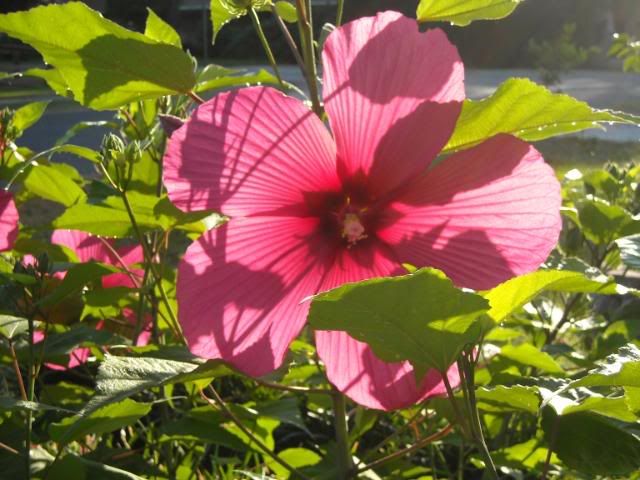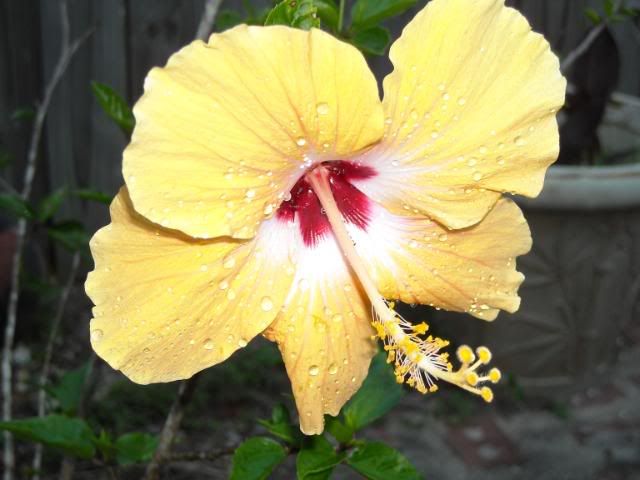My mom, of course, was less than excited about this prospect: her baby girl heading off to an island in Belize and - perhaps more importantly - missing Christmas with the family.
We flew from New Orleans to Belize City, where the runways were lined with military personnel and where we went through customs. We had cases full of scientific equipment, but the customs official wanted to know, "What is this Avon Skin-So-Soft?" It is apparently the only thing that prevents noseeum bites ... not because they are deterred by it, but perhaps because they drown before reaching skin so slathered!

THE "AIRPORT" IN DANGRIGA
From there, we hopped into a small four-seater plane to Dangriga which, incidentally, had gotten 24-hour electricity only the week before. Since I'd never flown in a small plane or been to Belize, I rode up front with the pilot. It was scary! We flew over the water the entire way from Belize City to Dangriga, where we landed on the above-pictured dirt runway. It was a pretty bumpy landing!
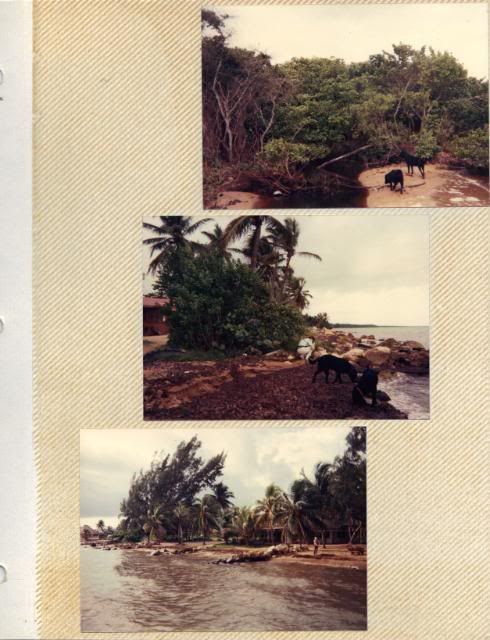
THE RESORT: Karen is in the middle picture.
We stayed at the Pelican Beach Resort where we were treated to local entertainment and freshly caught lobster. I am not a huge fan of lobster, but wanting to experience as much as I could, I tried it. The next day, I walked into the town of Dangriga to see the local shops; after I'd returned, I was told that Americans are frequently mugged and that it could be dangerous! Oops. But what a great experience to meet so many locals!
After we were joined by Karen's research partner, Candy, who was a full-time employee of the Smithsonian, we headed out to Carrie Bow Caye, a Smithsonian field research station.

CARRIE BOW CAYE
We rode in a Mexican Dory, and our boat captain was named Junior. It was about an hour or maybe 90 minutes to Carrie Bow, though it only took about five minutes to circum-ambulate the island upon arrival. Carrie Bow is about 3/4 of an acre in size, had no running water, no electricity due to a bum generator, and outhouses over the water.
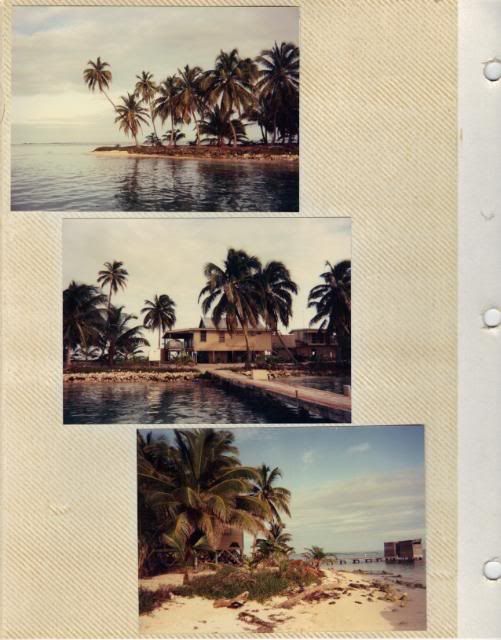
THE ISLAND: Note the outhouses in the bottom picture.
For entertainment, I had a cassette tape Walkman with a lot of extra batteries. The Cure was my band of choice, though I also indulged myself in the dry lab library, reading my first Michael Crichton book. There were ice boxes - literally - in which huge blocks of ice were placed with untold amounts of soda and Belikin beer, a then-popular Belizean beer.
When I wasn't working - think: measuring leaves, walking through thigh-high muck or on Rhizophera (red mangrove) roots, sifting through soil cores - I had the chance to snorkel. Carrie Bow was right on the coral reef, so I could literally walk off the island and see the sights.
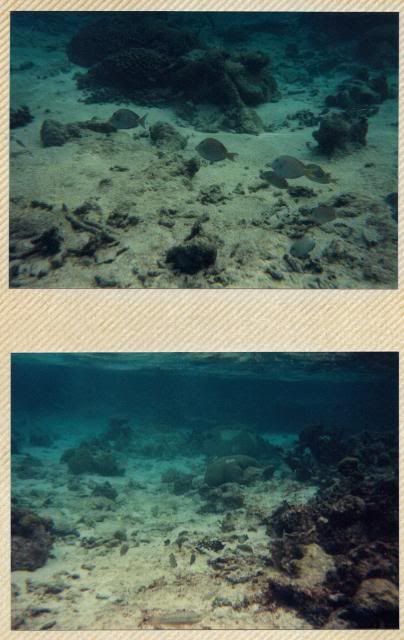
SNORKELING BEHIND CARRIE BOW ... FAR AWAY FROM THE OUTHOUSES!
One day, Junior invited me to join him on a charter to Glover's Reef. I got the day off and headed out on an adventure! A little boy named Rudy, age 7, joined us, as did the people who had booked the charter. We dropped the charter off on their island, Glover's Reef, where the resort was most popular because it offered mosquito netting (seriously!), and I got the chance to tour the island.
After we were finished walking around Glover's Reef, which was somewhat larger than Carrie Bow, we went fishing. Well, I went snorkeling, Junior went spearfishing, and Rudy drove the boat. We first watched some guys lobstering; I didn't realize that lobster-fishers would simply grab the lobsters with their bare hands! After we'd moved on to a better fishing spot, Junior would tap me on the shoulder and point to a tiny fish deep in the water, then he'd swim down, shoot the fish, and return with a bohemeth-sized specimen. He was swimming something like 40 - 50 feet deep simply by holding his breath. (I later learned that he had also cave-dived without a tank, simply by holding his breath. His lung capacity must have been amazing!)
I really enjoyed watching Junior spearfish and, later, after I was tired of swimming, chatting with Rudy as he drove the boat; nobody else ever called him by his name - only "Boy." After Junior would spear a fish, he swim to the surface and toss it in the boat. Rudy would grab the fish, some of which were nearly as he big as he was, and toss it in a cooler. It was all pretty amazing!
Once Junior had enough fish, we headed back to Carrie Bow. He cleaned the fish on the way back while Rudy drove. Throwing the fish debris over the side led to a nice following of sharks! When we returned to our island, the people there - Karen and Candy, plus 4 other scientists, another student worker, and our cook - decided that they would prepare ceviche with some of the freshly caught fish. There was much gin consumed during the preparation, and I was pleasantly surprised that there were no major injuries to any of the ceviche "chefs".
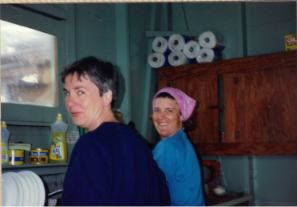
THE "CHEFS" AT WORK
The next morning, there were still sharks in the water, and the boats were anchored away from the shore. Candy walked through the water to our boat. I was a bit nervous since I could see shark fins about, but they scattered as she approached. We climbed in the boat and went to Twin Cayes, where much of our research was done. Many snakes inhabited Twin Cayes, including this boa constrictor that was nearly stepped on!
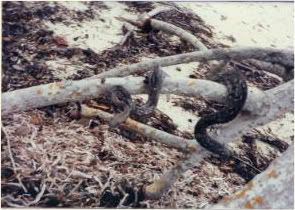
BOA
We headed back earlier than usual, eager to try the ceviche. Well, they were eager to try it; I was a bit hesitant since I am not a huge fan of fish, but it was delicious!
That was the only meal that our cook did not prepare; she would bake bread for field lunches of cheese or peanut butter sandwiches, she made breakfast every morning, dinner every night, squeezed fresh orange juice into our glasses, and baked coconut pies with coconuts she'd just picked. She also taught me to use a washboard for my laundry; I was not very good at it, so - lucky for me - she said "Give me that, girl!" And she made sure that my clothes were properly cleaned.
At night, because there was no electricity, the sky was amazing! (Truly, "amazing" is an appropriate word!) The stars were uncountable and so bright that they cast shadows on the ground. During the week we had a nearly full moon, the light was so bright that it was almost as though we were walking in daylight. Several of us would lie on the boat dock at night, watching the stars, talking only if a thought needed to be shared. One night, we were treated to phosphorescent fish swimming around the dock. Another time, an octopus was startled and squirted a dark, inky fog that enabled him to escape.
And crabs: crabs were everywhere! The hermit crabs would hang out behind the kitchen, just like any scavenger, and they would find anything to back into as they outgrew their shells. Some were walking around with syringes instead of shells! That was quite a site to see, though I've lost the pictures somewhere along the way.
We also had scientists studying crabs. When some of the specimen crabs molted and, during the process, pinched each others' legs off, we boiled and ate them, dipping each delectable morsel of crab meat in the best lemon-butter sauce I've ever had.
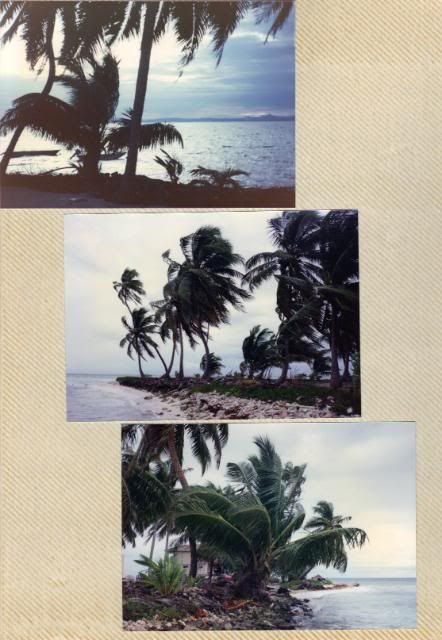
THE VIEW
Saying "yes" to this trip was one of the smartest decisions I've ever made. It was life-altering for me, and I am eternally grateful to Karen for giving me the opportunity. Would I go again, knowing that I would have no running water (we used cisterns) or electricity (the generator was repaired before we left, and I admit that much of the magic disappeared with the lights), or that I'd be pottying over a hole in a board over the ocean? Absolutely! I'm simply waiting for the call .........






